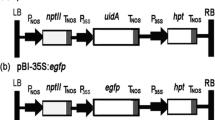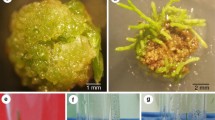Abstract
A vector for Agrobacterium tumefaciens-mediated transformation of basidiomycetes was constructed by insertion of a modified hygromycin resistance gene into the plant binary vector pBin19. The hygromycin coding region is flanked by a basidiomycete promoter and terminator. Isolates from different anastomosis groupings (AG) of the phytopathogenic fungus Rhizoctonia solani (Kuhn) were transformed with this vector using A. tumefaciens. Hygromycin-resistant transformants were isolated from a single AG6 isolate, but not from AG3 or AG4 isolates. Of six transformants isolated, five showed enhanced growth on agar containing either 25 or 50 ⧎g/mL hygromycin. However, as the hygromycin concentration increased, the difference between the transformants and the control reduced, until at 100 ⧎ g/mL there was no difference. The resistance phenotype was retained through repeated subcultures on non-selective media. The presence of the gene in the transformants was confirmed by PCR analysis and Southern hybridisation.
Similar content being viewed by others
References
Bej AK, Perlin MH (1989) A high efficiency transformation system for the basidiomycete Ustilago violaceae. Gene 80, 171–176. doi: 10.1016/0378-1119(89)90263-1
Bevan MW (1984) Binary Agrobacterium vectors for plant transformation. Nucleic Acids Research 12, 8711–8721. doi: 10.1093/nar/12.22.8711
Bora P, Hardy GEStJ, O’Brien PA (2005) Laccase is required for maceration of lupin radicle tissue by Rhizoctonia solani. Australasian Plant Pathology 34, 591–594. doi: 10.1071/AP05077
Breen A, Singleton F (1999) Fungi in lignocellulose breakdown and biopulping. Current Opinion in Biotechnology 10, 252–258. doi: 10.1016/S0958-1669(99)80044-5
Bundock P, Hooykas PJJ (1996) Integration of Agrobacterium tumefaciens T-DNA in the Saccharomyces cerevisiae genome by illegitimate recombination. Proceedings of the National Academy of Science of the United States of America 93, 15272–15275. doi: 10.1073/pnas.93.26.15272
Carling DE (1996) Grouping in Rhizoctonia solani by hyphal anastomosis. In ‘Rhizoctonia species: taxonomy, molecular biology, pathology, and disease control’. (Eds B Sneh, S Jabaji-Hare, SN Dijst) pp. 35–48. (Kluwer Academic Publishers: Dordrecht, the Netherlands)
Claus H (2004) Laccases: structure, reactions, distribution. Micron (Oxford, England) 35, 93–96.
Cogoni C (2001) Homology-dependent gene silencing mechanisms in fungi. Annual Review of Microbiology 55, 381–406. doi: 10.1146/annurev. micro.55.1.381
Couto SR, Herrera LT (2006) Inhibitors of laccases: a review. Current Enzyme Inhibition 2, 343–352. doi: 10.2174/157340806778699262
Cruickshank RH (1990) Pectic zymograms as criteria in taxonomy of Rhizoctonia. Mycological Research 94, 938–946.
deGroot MJA, Bundock P, Hooykaas PJJ, Beijersbergen AGM (1998) Agrobacterium tumefaciens-mediated transformation of filamentous fungi. Nature Biotechnology 16, 839–842. doi: 10.1038/nbt0998-839
Duncan S, Barton JE, O’Brien PA (1993) Analysis of variation in isolates of Rhizoctonia solani by random amplified polymorphic DNA assay. Mycological Research 97, 1075–1082.
Gelvin SB (2000) Agrobacterium and plant genes involved in T-DNA transfer and integration. Annual Review of Plant Physiology and Plant Molecular Biology 51, 223–256. doi: 10.1146/annurev.arplant.51.1.223
Gelvin SB (2003) Agrobacterium-mediated plant transformation: the biology behind the ‘gene-jockeying’ tool. Microbiology and Molecular Biology Reviews 67, 16–37. doi: 10.1128/MMBR.67.1.16-37.2003
Hooykaas PJJ (1988) Agrobacterium molecular genetics. In ‘Plant molecular biology manual’. (Eds SB Gelvin, RA Schilperoort, DPS Verma) pp.A4: 1–13. (Kluwer Academic Publishers: Dordrecht, the Netherlands)
Keller N, Bergstrom G, Yoder O (1991) Mitotic stability of transforming DNA is determined by its chromosomal configuration in the fungus Cochliobolus heterostrophus. Current Genetics 19, 227–233. doi: 10.1007/BF00336491
Lazo G, Stein P, Ludwig R (1991) A DNA transformation-competent Arabidopsis genomic library in Agrobacterium. Biotechnology 9, 963–967. doi: 10.1038/nbt1091-963
Litvintseva A, Henson J (2002) Characterization of two laccase genes of Gaeumannomyces graminis var. graminis and their differential transcription in melanin mutants and wild type. Mycological Research 106, 808–814. doi: 10.1017/S0953756202005841
Lugones K, Schioltmeijer K, Klootwijk R, Wessels J (1999) Introns are necessary for mRNA accumulation in Schizophyllum commune. Molecular Microbiology 32, 681–689. doi: 10.1046/j.1365-2958. 1999.01373.x
MacNish GC, O’Brien PA (2005) RAPD-PCR used to confirm that four pectic isozyme (zymogram) groups within the Australian Rhizoctonia solani AG 8 population are true intraspecific groups. Australasian Plant Pathology 34, 245–250. doi: 10.1071/AP05004
Mayer AM, Staples RC (2002) Laccase: new functions for an old enzyme. Phytochemistry 60, 551–565. doi: 10.1016/S0031-9422(02)00171-1
Mellon FM, Little PFR, Casselton LA (1987) Gene cloning and transformation in the basidiomycete fungus Coprinus cinereus: isolation and expression of the isocitrate lyase gene (acu-7). Molecular & General Genetics 210, 352–357. doi: 10.1007/BF00325705
Meyer V (2008) Genetic engineering of filamentous fungi — progress, obstacles and future trends. Biotechnology Advances 26, 177–185. doi: 10.1016/j.biotechadv.2007.12.001
Miller P (1955) V-8 juice as a general purpose medium for fungi and bacteria. Phytopathology 45, 461–462.
Mooibroek H, Juipers A, Sietsma J, Punt P, Wessels J (1990) Introduction of hygromycin B resistance into Schizophyllum commune. Molecular & General Genetics 222, 41–48.
Mullins ED, Chen X, Romaine P, Raina D, Geiser DM, Kang S (2001) Agrobacterium-mediated transformation of Fusarium oxysporum: an efficient tool for insertional mutagenesis and gene transfer. Phytopathology 91, 173–180. doi: 10.1094/PHYTO.2001.91.2.173
Muskens MWM, Vissers APA, Mol JNM, Kooter JM (2000) Role of inverted DNA repeats in transcriptional and post-transcriptional gene silencing. Plant Molecular Biology 43, 243–260. doi: 10.1023/A:1006491613768
O’Brien PA (1994) Molecular markers in Australian isolates of Rhizoctonia solani. Mycological Research 98, 665–671.
Parmeter JR, Whitney HS (1970) Taxonomy and nomenclature of the imperfect state. In ‘Rhizoctonia solani, biology and pathology’. (Ed. JR Parmeter) pp. 7–19. (University of California Press: Berkeley, CA)
Piers KL, Heath JD, Liang X, Stevens KM, Nester EW (1996) Agrobacterium tumefaciens-mediated transformation of yeast. Proceedings of the National Academy of Science of the United States of America 93, 1613–1618. doi: 10.1073/pnas.93.4.1613
Renno D, Saunders G, Smith P, Bull A, Holt G (1992) Mitotic instability of integrated plasmids in Penicillium chrysogenum transformants. Journal of Biotechnology 24, 291–298. doi: 10.1016/0168-1656(92)90038-B
Robinson H, Deacon J (2001) Protoplast preparation and transient transformation of Rhizoctonia solani. Mycological Research 105, 1295–1303. doi: 10.1017/S0953756201005159
Sawada H, Ieki H, Matsuda I (1995) PCR detection of Ti and Ri plasmids from phytopathogenic Agrobacterium strains. Applied and Environmental Microbiology 61, 828–831.
Scholtmeijer K, Wosten H, Springer J, Wessels J (2001) Effect of introns and AT-rich sequences on expression of the bacterial hygromycinBresistance gene in the basidiomycete Schizophyllum commune. Applied and Environmental Microbiology 67, 481–483. doi: 10.1128/AEM.67.1. 481-483.2001
Sharon M, Kuninaga S, Hyakumachi M, Naito S, Sneh B (2008) Classification of Rhizoctonia spp. using rDNA-ITS sequence analysis supports the genetic basis of the classical anastomosis grouping. Mycoscience 49, 93–114. doi: 10.1007/s10267-007-0394-0
Sneh B, Burpee LL, Ogoshi A (1991) ‘Identification of Rhizoctonia species.’ (APS Press: St Paul, MN)
Sweetingham MW, Cruickshank RH, Wong DH (1986) Pectic zymograms and taxonomy and pathogenicity of the Ceratobasidiaceae. Transactions of the British Mycological Society 86, 305–311.
Ullrich R, Novotny C, Specht C, Froelinger E, Miunoz-Rivas A (1985) Transforming basidiomycetes. In ‘Molecular genetics of filamentous Fungi’. (Ed. W Timberlake) pp. 39–57. (AR Liss Inc.: New York)
Wang J, Holden DW, Leong SA (1988) Gene transfer system for the phytopathogenic fungus Ustilago maydis. Proceedings of the National Academy of Science of the United States of America 85, 865–869. doi: 10.1073/pnas.85.3.865
Author information
Authors and Affiliations
Corresponding author
Rights and permissions
About this article
Cite this article
Wu, J., O’Brien, P.A. Stable transformation of Rhizoctonia solani with a modified hygromycin resistance gene. Australasian Plant Pathology 38, 79–84 (2009). https://doi.org/10.1071/AP08081
Received:
Accepted:
Issue Date:
DOI: https://doi.org/10.1071/AP08081




